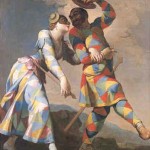As I noted the other day, commedia dell’arte and opera are the dual threads that eventually spun into what we call musical theater. We’ve explored opera’s role, now let’s take a closer look at that first thread. Commedia dell’arte began in Renaissance Italy and quickly spread throughout Europe. It didn’t use playwrights or directors. The company manager would announce a title and a give his troupe a short scenario of basic plot points. Within this loose framework, the actors would improvise a unique performance, using whatever physical slapstick and comic shtick they felt appropriate. Commedia relied on the virtuosity of its performers.
Most actors specialized in one of four main archetypes: the cunning servant; the greedy old man; the young lovers; or the boastful captain. These characters made their way into 18th-century British pantomimes, which incorporated song and dance, clowning, and slapstick but were scripted. The traditional story depicted eloping lovers pursued by the girl’s father and his servants, but pantomimes became more topical as they began to compete with the increasingly popular music hall entertainment. Originating in British saloon bars of the 1830s, music halls allowed audiences to eat, drink, and smoke during its shows, which relied more than pantos did on the unscripted physical slapstick and comic shtick of commedia.
As music halls were sprouting up in London, dime museums (the American counterpart) were opening in New York, many along the Bowery. Designed as centers for the entertainment and “moral education” of the working class, primarily recent immigrants, these “museums” purposefully set themselves apart as a cheap alternative to middle class theaters. Although “lowbrow,” dime museums were the training ground for scores of vaudeville entertainers, from magician Harry Houdini to comedians Weber & Fields. In From the Bowery to Broadway, Armond Fields noted, “If the art and business of modern Broadway could be said to have a specific birthplace, it was in the Bowery, in its dime museums, dance halls, and beer gardens.”
Many vaudeville performers went on to create shows for themselves, such as the team of George Walker and Bert Williams. The most successful went on to produce shows for themselves, such as the teams of Ned Harrigan and Tony Hart at Theatre Comique and Joe Weber and Lew Fields at Broadway Music Hall. The premiere showcase, though, became Florenz Ziegfeld’s Follies productions, which were inspired by the Folies Bergère of Paris. The first American Follies premiered in 1907 at Jardin de Paris, the Liberty Theatre’s rooftop venue, and was so popular that a new edition opened every year through 1925, with an additional six editions appearing occasionally until 1957.
These extravagant revues featured star performers such as Josephine Baker, Fanny Brice, Bob Hope, Helen Morgan, Will Rogers, and Bert Williams — as well as the Ziegfeld chorus girls — performing songs by star writers including Irving Berlin, Rudolf Friml, George Gershwin, Victor Herbert, Jerome Kern, and Harry Warren. The craft of American musical theater was built by this group of artists, beginning with Ziegfeld’s 1927 production of Jerome Kern’s Show Boat with Helen Morgan.
As writer Miles Kreuger said, “The history of the American musical theater is divided quite simply into two eras: everything before Show Boat and everything after Show Boat.” However, that milestone didn’t appear spontaneously. The two decades between 1907 and 1927 were important formative years for the emerging musical theater.
To sample the American roots of musical theater, explore “Mulligan Guard” (listen here) from Mulligan Guard (1873) by Harrigan & Hart, “The Bowery” (listen here) from A Trip to Chinatown (1891) by Charles Hoyt, “The Hypnotist” (listen here) by Weber & Fields (1904), and “Nobody” (listen here) from Abyssinia (1905) by Bert Williams.

